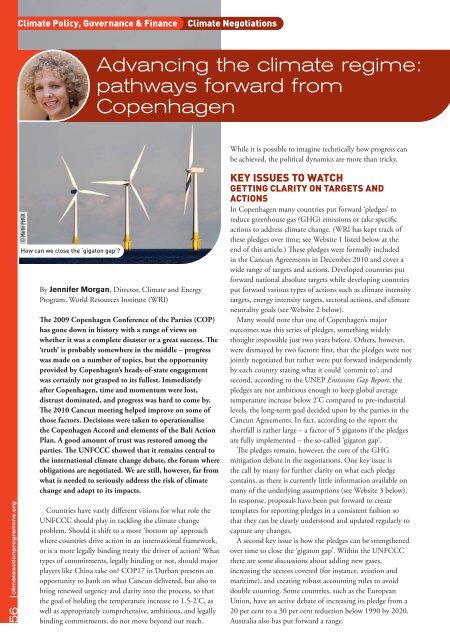Climate Action 2011-2012
You also want an ePaper? Increase the reach of your titles
YUMPU automatically turns print PDFs into web optimized ePapers that Google loves.
climate Policy, Governance & Finance<br />
climate negotiations<br />
Advancing the climate regime:<br />
pathways forward from<br />
Copenhagen<br />
While it is possible to imagine technically how progress can<br />
be achieved, the political dynamics are more than tricky.<br />
56 climateactionprogramme.org<br />
© Martin Pettitt<br />
How can we close the ‘gigaton gap’?<br />
By Jennifer Morgan, Director, <strong>Climate</strong> and Energy<br />
Program, World Resources Institute (WRI)<br />
The 2009 Copenhagen Conference of the Parties (COP)<br />
has gone down in history with a range of views on<br />
whether it was a complete disaster or a great success. The<br />
‘truth’ is probably somewhere in the middle – progress<br />
was made on a number of topics, but the opportunity<br />
provided by Copenhagen’s heads-of-state engagement<br />
was certainly not grasped to its fullest. Immediately<br />
after Copenhagen, time and momentum were lost,<br />
distrust dominated, and progress was hard to come by.<br />
The 2010 Cancun meeting helped improve on some of<br />
those factors. Decisions were taken to operationalise<br />
the Copenhagen Accord and elements of the Bali <strong>Action</strong><br />
Plan. A good amount of trust was restored among the<br />
parties. The UNFCCC showed that it remains central to<br />
the international climate change debate, the forum where<br />
obligations are negotiated. We are still, however, far from<br />
what is needed to seriously address the risk of climate<br />
change and adapt to its impacts.<br />
Countries have vastly different visions for what role the<br />
UNFCCC should play in tackling the climate change<br />
problem. Should it shift to a more ‘bottom up’ approach<br />
where countries drive action in an international framework,<br />
or is a more legally binding treaty the driver of action? What<br />
types of commitments, legally binding or not, should major<br />
players like China take on? COP17 in Durban presents an<br />
opportunity to bank on what Cancun delivered, but also to<br />
bring renewed urgency and clarity into the process, so that<br />
the goal of holding the temperature increase to 1.5-2 º C, as<br />
well as appropriately comprehensive, ambitious, and legally<br />
binding commitments, do not move beyond our reach.<br />
Key issues to watch<br />
GettinG clarity on tarGets and<br />
actions<br />
In Copenhagen many countries put forward ‘pledges’ to<br />
reduce greenhouse gas (GHG) emissions or take specific<br />
actions to address climate change. (WRI has kept track of<br />
these pledges over time; see Website 1 listed below at the<br />
end of this article.) These pledges were formally included<br />
in the Cancun Agreements in December 2010 and cover a<br />
wide range of targets and actions. Developed countries put<br />
forward national absolute targets while developing countries<br />
put forward various types of actions such as climate intensity<br />
targets, energy intensity targets, sectoral actions, and climate<br />
neutrality goals (see Website 2 below).<br />
Many would note that one of Copenhagen’s major<br />
outcomes was this series of pledges, something widely<br />
thought impossible just two years before. Others, however,<br />
were dismayed by two factors: first, that the pledges were not<br />
jointly negotiated but rather were put forward independently<br />
by each country stating what it could ‘commit to’; and<br />
second, according to the UNEP Emissions Gap Report, the<br />
pledges are not ambitious enough to keep global average<br />
temperature increase below 2 º C compared to pre-industrial<br />
levels, the long-term goal decided upon by the parties in the<br />
Cancun Agreements. In fact, according to the report the<br />
shortfall is rather large – a factor of 5 gigatons if the pledges<br />
are fully implemented – the so-called ‘gigaton gap’.<br />
The pledges remain, however, the core of the GHG<br />
mitigation debate in the negotiations. One key issue is<br />
the call by many for further clarity on what each pledge<br />
contains, as there is currently little information available on<br />
many of the underlying assumptions (see Website 3 below).<br />
In response, proposals have been put forward to create<br />
templates for reporting pledges in a consistent fashion so<br />
that they can be clearly understood and updated regularly to<br />
capture any changes.<br />
A second key issue is how the pledges can be strengthened<br />
over time to close the ‘gigaton gap’. Within the UNFCCC<br />
there are some discussions about adding new gases,<br />
increasing the sectors covered (for instance, aviation and<br />
maritime), and creating robust accounting rules to avoid<br />
double counting. Some countries, such as the European<br />
Union, have an active debate of increasing its pledge from a<br />
20 per cent to a 30 per cent reduction below 1990 by 2020.<br />
Australia also has put forward a range.












